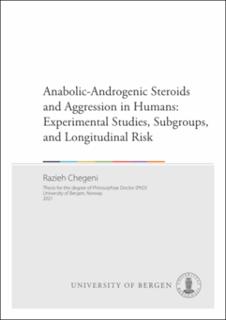| dc.description.abstract | Anabolic-androgenic steroid (AAS) use is a global public health concern. However, the relationship between AAS use and its psychological side effects, specifically aggression needs further elucidation. Results from experimental studies on this topic are inconsistent. Moreover, no previous study has examined patterns of aggression and psychological distress among male and female AAS users. Finally, although some studies have examined risk factors of AAS use in cross-sectional samples, there is a dearth of longitudinal studies on prevalence and risk factors for AAS use, particularly aggression, from late adolescence to early adulthood. Three studies were conducted to shed light on the aforementioned gaps in the literature. The aim of the first study was to systematically review and meta-analyse results from human randomized controlled trials (RCTs) on the effect of AAS administration on aggression. The second study aimed to investigate the patterns of aggression and psychological distress among AAS users among male and female AAS users. The third study aimed to examine the prevalence of AAS use, and longitudinal risk factors for AAS use intent, especially physical and verbal aggression, from late adolescence to early adulthood.
A systematic review and meta-analysis was conducted to accomplish the first study’s aim. Twelve RCTs comprising a total of 562 healthy males were identified and included in the meta-analysis after systematic searches of MEDLINE, PsycINFO, ISI Web of Science, ProQuest, Google Scholar, and the Cochrane Library. The Q-statistic and I2 index were utilized to assess heterogeneity. Additionally, to achieve the aim of the second study, a cross-sectional survey was conducted on 206 AAS users (females = 58.30%) in Iran. Participants’ ages ranged from 14 to 56 (M = 26.86, SD = 7.12). Data was collected from Tehran, Iran. The questionnaire comprised questions on demographics, AAS use, aggression and psychological distress. A multigroup latent class analysis (MLCA) was conducted to elucidate patterns of aggression and psychological distress among this sample. Measurement invariance examined sex-specificity of identified patterns of aggression and psychological distress. Moreover, to accomplish the aim of the third study, a longitudinal study of the prevalence of AAS use, and risk factors of AAS use intent, particularly the role of physical and verbal aggression from age 18 to 19 was conducted in Norway. At the first wave, 1,333 18-year-olds (females = 58.9%) completed a questionnaire containing demographic, AAS use and intent, other substance (alcohol, cigarette, and snus) use, aggression, anxiety, and depression. At age 19 (N = 1277, females = 61.7%), they completed the same set of questionnaires. To analyse the data descriptive statistics, correlations, and hierarchical multiple regression were utilized
Results of the first study, after excluding an outlier, indicated that AAS administration is associated with a small increase in self-reported aggression using a random-effects model. This result was replicated when restricting the analysis to the effect of acute AAS administration on self-reported aggression under a fixed-effect model. For the second study, the MLCA identified five subgroups of AAS users. The first and smallest subgroup (7.63%) comprised highly aggressive and moderately distressed users. The second subgroup (18.64%) consisted of moderately aggressive and distressed users. The third subgroup (22.95%) was composed of users with moderate levels of direct aggression (physical and verbal aggression) as well as distress, and mild levels of indirect aggression (anger and hostility). The fourth subgroup (11.71%) was made up of users with mild levels of direct aggression and moderate levels of indirect aggression and psychological distress. Finally, the fifth and largest subgroup (39.06%) encompassed users with low levels of aggression and mild levels of psychological distress. Results from measurement invariance analysis indicated that a homogenous five-class solution is the best model for both sexes. However, sex was significantly associated with the probability of belongingness to subgroups with members of the highly aggressive and moderately distressed subgroup more likely to be male users whereas members of the fifth subgroup were more likely to be female. Results of the third study indicated an AAS use prevalence of 1 person at age 18 to 4 persons at age 19. AAS use intent, being male, living alone, and actual AAS use at age 18 were predictive risk factors of AAS use intent at age 19. From age 18 to 19, physical aggression and verbal aggression decreased significantly in both sexes and, did not predict AAS use intent at age 19.
Altogether, it can be inferred from the above results that AAS administration increases aggression in RCTs. Additionally, the above results provide evidence of the idiosyncratic patterns of aggression and psychological distress among male and female AAS users, and denote the lack of prospective associations between physical or verbal aggression and AAS use intent from ages 18 to 19. Findings from these studies contribute to the evidence base on AAS use and aggression. Potential applications of these findings in future research, policymaking and public health interventions is also discussed. | en_US |
| dc.relation.haspart | Paper I. Chegeni, R., Pallesen, S., McVeigh, J., & Sagoe, D. (2021). Anabolic-androgenic steroid administration increases self-reported aggression in healthy males: A systematic review and meta-analysis of experimental studies. Psychopharmacology. The article is available at: <a href="https://hdl.handle.net/11250/2767216" target="blank">https://hdl.handle.net/11250/2767216</a> | en_US |
| dc.relation.haspart | Paper II. Chegeni, R., Notelaers, G., Pallesen, S., & Sagoe, D. (2021). Aggression and psychological distress in male and female anabolic–androgenic steroid users: A multigroup latent class analysis. Frontiers in Psychiatry. Front. Psychiatry 12:629428. The article is available in the thesis. The article is also available at: <a href="https://doi.org/10.3389/fpsyt.2021.629428" target="blank">https://doi.org/10.3389/fpsyt.2021.629428</a> | en_US |
| dc.relation.haspart | Paper III. Chegeni, R., Sagoe, D., Mentzoni, R. A., & Pallesen, S. (2019). Aggression and anabolic–androgenic steroid use intent in adolescents: A longitudinal study. Substance Use & Misuse, 54, 1509–1518. The article is available at: <a href="https://hdl.handle.net/1956/22155" target="blank">https://hdl.handle.net/1956/22155</a> | en_US |

